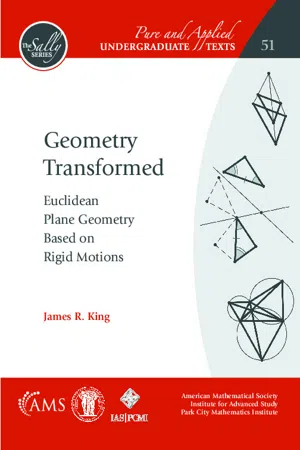Mathematics
Area of a Kite
The area of a kite can be calculated using the formula A = (d1 * d2) / 2, where d1 and d2 are the lengths of the diagonals. A kite is a quadrilateral with two distinct pairs of adjacent sides that are equal in length. The area of a kite is half the product of its diagonals.
Written by Perlego with AI-assistance
Related key terms
1 of 5
3 Key excerpts on "Area of a Kite"
- eBook - PDF
- Daniel C. Alexander, Geralyn M. Koeberlein(Authors)
- 2019(Publication Date)
- Cengage Learning EMEA(Publisher)
We will deal with rectangles in the next section. THE KITE The next type of quadrilateral that we consider is known as a kite, a quadrilateral that gets its name from the child’s toy pictured at the left. In the construction of the kite shown to the left (or any other kite), there are two pairs of congruent adjacent sides. See Figure 4.14(a) on page 193. Consider the Discover activity at the left. Through it, we discover additional relation- ships that determine a quadrilateral to be a parallelogram. This activity also leads to the following theorem; proof of which is left to the student in Exercise 25. Theorem 4.2.2 If both pairs of opposite sides of a quadrilateral are congruent, then the quadrilateral is a parallelogram. Theorem 4.2.3 If the diagonals of a quadrilateral bisect each other, then the quadrilateral is a parallelogram. Theorem 4.2.4 In a kite, one pair of opposite angles are congruent. Another quality that determines a quadrilateral to be a parallelogram is found in Theorem 4.2.3. Its proof is also left to the student in Exercise 26. A kite is a quadrilateral with two distinct pairs of congruent adjacent sides. DEFINITION See the Discover activity at the lower left. The word distinct is used in the definition of kite to clarify that the kite does not have four congruent sides. The word adjacent is necessary for the quadrilateral to be a kite; if the word adjacent were replaced by the word opposite, the quadrilateral described would be a parallelogram. In Example 2, we verify Theorem 4.2.4 by proving that uni2220B _ uni2220D in Figure 4.14(a) on page 193. With congruent sides as marked, uni2220A R uni2220C in kite ABCD. EXAMPLE 2 Complete the proof of Theorem 4.2.4. GIVEN: Kite ABCD with congruent sides as marked. [See Figure 4.14(a).] PROVE: uni2220B _ uni2220D Discover Take two straws and cut each straw into two pieces so that the lengths of the pieces of one straw match those of the second. - eBook - PDF
Geometry Transformed
Euclidean Plane Geometry Based on Rigid Motions
- James R. King(Author)
- 2021(Publication Date)
- American Mathematical Society(Publisher)
Instead of doubling the triangle, it can be cut apart and re-assembled as a rectangle, as shown in Figure 8. Figure 8. Area Formula for a Triangle from Dissection to a Rectangle The Area of a Kite can be deduced from the area of a triangle. This is posed as a problem in the exercises. Area Proofs of the Pythagorean Theorem There are many area proofs of the Pythagorean Theorem. If ? is a right triangle with hypotenuse length ? and the other side lengths ? and ? , the Pythagorean relationship ? 2 = ? 2 + ? 2 can be considered as an equation of areas. It is often represented by a picture like Figure 9, with the triangle ? and three squares attached to the sides. The area of the square on the hypotenuse equals the sum of the areas of the other two squares. c a b C B A Figure 9. Pythagorean Theorem Expressed as an Area Equation 166 9. Area and Its Applications a c b b a b a B C A Figure 10. Dissection and Area Proof of the Pythagorean Theorem Figure 10 shows a famous and venerable area proof. Let ? = △??? , a right triangle with hypotenuse ?? of length ? and with leg lengths ? and ? . Arrange four triangles congruent to ? in the corners of a square of side ? + ? in a rotationally sym-metric manner. This is shown on the left side of the figure. (The triangles are arranged as the rectangles were arranged in Figure 3.) By rotational symmetry, the quadrilateral ??? ′ ? ′ formed by the four hypotenuses is a square with side length ? . The area of this square is the difference of the area of the big square less the four triangle areas. On the right of Figure 10 is the same square with the same four triangles reposi-tioned so that the empty space consists of two squares, one of side length ? and the other ? . Therefore, ? 2 = 𝒜(??? ′ ? ′ ) = ? 2 + ? 2 . Notice that the geometrical figure on the right is an area model for the algebraic equation (? + ?) 2 = ? 2 + 2?? + ? 2 . Y Z X W C 1 ' B' C' B 1 ' O A 2 C 2 C 1 B 1 B 3 A 3 C B A Figure 11. - No longer available |Learn more
- Daniel C. Alexander, Geralyn M. Koeberlein, , , Daniel C. Alexander, Geralyn M. Koeberlein(Authors)
- 2014(Publication Date)
- Cengage Learning EMEA(Publisher)
1–4 THEOREM 4.2.2 If both pairs of opposite sides of a quadrilateral are congruent, then the quadrilateral is a parallelogram. THEOREM 4.2.3 If the diagonals of a quadrilateral bisect each other, then the quadrilateral is a parallelogram. THEOREM 4.2.4 In a kite, one pair of opposite angles are congruent. A B D C See the Discover activity at the lower left. The word distinct is used in the definition of kite to clarify that the kite does not have four congruent sides. The word adjacent is necessary for the quadrilateral to be a kite; if the word adjacent were replaced by the word opposite , the quadrilateral described would be a parallelogram. In Example 2, we verify Theorem 4.2.4 by proving that in Figure 4.14(a) on page 181. With congruent sides as marked, in kite ABCD . EXAMPLE 2 Complete the proof of Theorem 4.2.4. GIVEN: Kite ABCD with congruent sides as marked. [See Figure 4.14(a).] PROVE: ∠ B ∠ D ∠ A ∠ C ∠ B ∠ D A kite is a quadrilateral with two distinct pairs of congruent adjacent sides. DEFINITION Copyright 2013 Cengage Learning. All Rights Reserved. May not be copied, scanned, or duplicated, in whole or in part. Due to electronic rights, some third party content may be suppressed from the eBook and/or eChapter(s). Editorial review has deemed that any suppressed content does not materially affect the overall learning experience. Cengage Learning reserves the right to remove additional content at any time if subsequent rights restrictions require it. Figure 4.14 PROOF Statements Reasons The proof of Theorem 4.2.4 required auxiliary diagonal ; if drawn, diagonal would not determine two congruent triangles—thus, no help! When observing an old barn or shed, we often see that it has begun to lean. Unlike a triangle, which is rigid in shape [Figure 4.15(a)] and bends only when broken, a quadrilat-eral [Figure 4.15(b)] does not provide the same level of strength and stability.
Index pages curate the most relevant extracts from our library of academic textbooks. They’ve been created using an in-house natural language model (NLM), each adding context and meaning to key research topics.


